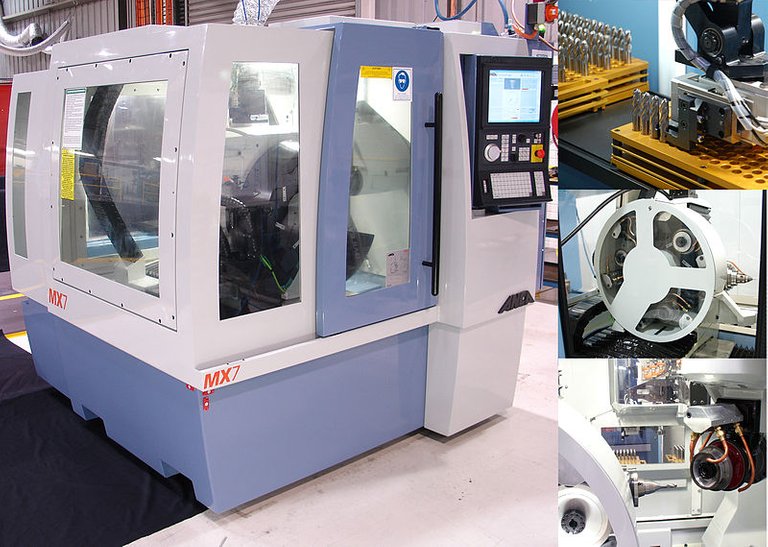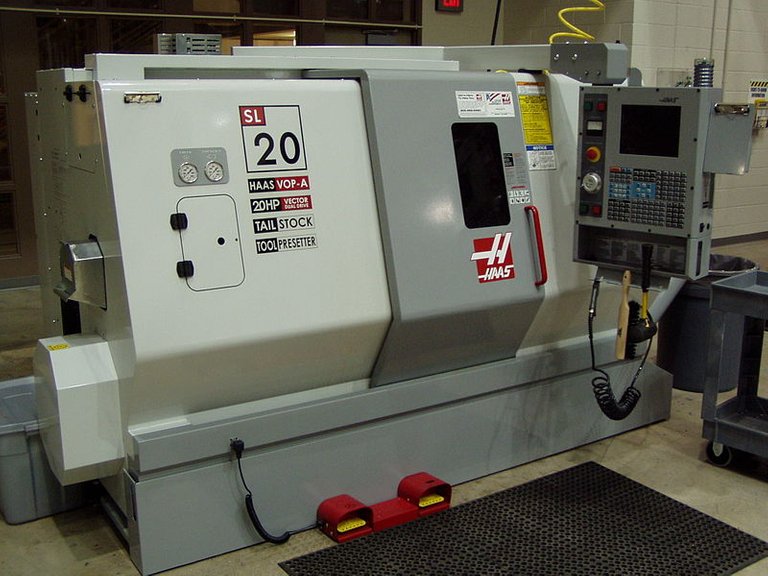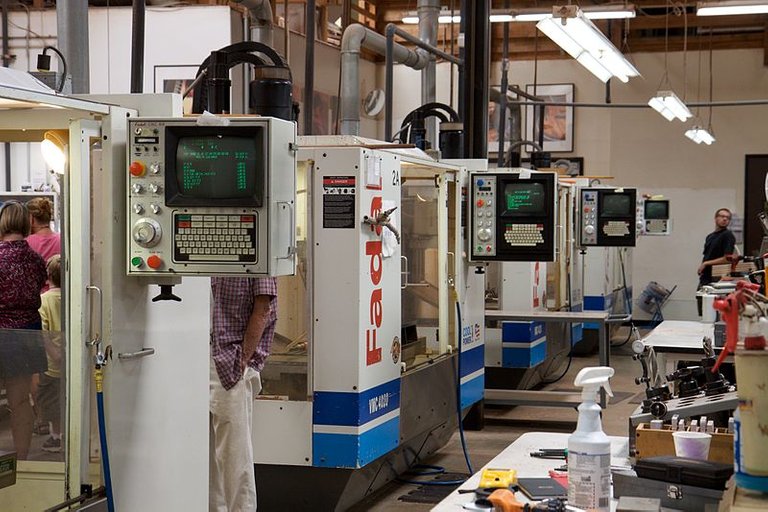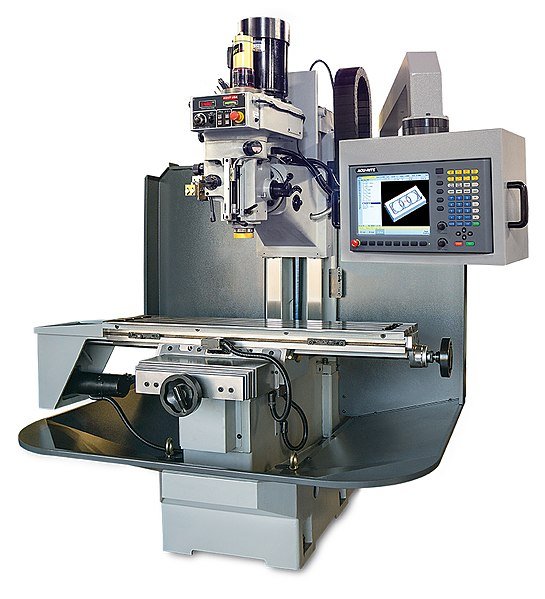Welcome to my blog once again, it's a sunny day over here, and it's been an engaging one. I hope you found yours interesting too.
I've brought you an interesting topic about manufacturing today, it is about CNC (Computer Numerical Control) Machines. Well, if the name appeared too big, let's break it down, shall we?First,we all know what Computers are, so let's focus on knowing what Numerical control is. The Oxford Dictionaries explains that it is a process of using numerical data to direct Computers so that the computer can in turn, control machine tools. You will find a more detailed explanation as you read on.
These machines have become commonplace in today's manufacturing world. In fact when I was first introduced to theses machines in 2014, I thought they were a knew technology, turns out I was spectacularly wrong, the Numerical Control system has been around for more than 70 years now. I hope you're not about to tell me that we have men who operate these machines already, yes may if these machines thT are manually operated still exist, but their end is not so far away. Why?
There is a significant reason why modern manufacturing has favoured the use of CNC machines over Manual manufacturing. To explain this better, let me a secondary school experience with you.
I was a very stubborn secondary school student, a disciplinary nightmare of any teacher. Whenever the list of noise-makers is compiled, you can be sure my name is at the top of the list. There were of course those teachers who believed in corporal punishment, but then there were those who preferred mental torture, and these ones are those we try to avoid. Unfortunately for me, I fell into the hands of one of those teachers know the latter category, I along with my clique were disturbing the class with noise again.
Unlike the other teachers, this one didn't come with any cane, neither did he ask us to do any form of painful physical exercise, after a long wait, he told each of us to buy a 60 leaves notebook and write I WILL NEVER MAKE NOISE AGAIN 2,000 times. I'm laughing now, as I stupidly was when I heard the punishment, "how hard can that possibily be", I thought. Well it was the worst punishment I received in secondary school. If you still think it's a simple task, try writing it 100 times.
Now, I'm assuming you had your laugh already, and you're wondering how the story has to do with manufacturing. Actually, that experience taught me a great lesson about manual repetition. Just like you, I also have a unique handwriting, but by the time I picked up my completed punishment notebook (that I wrote all by myself, as that was part of the instructions), I noticed serious variations in my handwriting; at the beginning, when I was spirited, sure of completing the "easy task", my handwriting was intact, but as I realised how much trouble I've gotten into, and grew weary of the task, my handwriting also grew weary so to speak.
When I just finished eating, I wrote more clearly than when it's getting late. In fact as the deadline grew closer, I was only concerned about finishing the task, I had abandoned finesse. I wasn't the only one who has these variations though, different levels were noticed among my colleagues too.
What is my point? To get it clearly, imagine that we were simply asked to type those words with Microsoft Word, using Times New Roman, font size (12) with double spacing, how much variation will be noticed?, will the teacher have been able to determine who typed which?
Do you get my point now? Human repetition leads to variations, no matter how little they may be. Of course, the variations in my handwriting did not cause any lasting harm, as the teacher could recognise the reasons for those variations. However, imagine that the charging port of that phone you're holding or of the laptop you are reading from was manufactured to be just a little bit wider than it is supposed to be, how interesting do you think it will be to charge that device? Will you not complain to the manufacturer?
Yes, as interesting as manufacturing is for humans, when it comes to machining several parts into the same dimensions, over and over again, it is only normal that there will be slight variations in the eventual dimensions of those machined parts, either due to stress, lack of concentration or other factors on the part of the operator. But, remember, the dimensions of those parts were reached after design calculations, and to fit into its space relative to other parts of the machine. For that reason, these little variations can have great negative effects.
This has been a problem faced by bulk manufacturers of machines. Take a car factory for example, a particular model of a car will of course have the same dimensions for its crankshaft, but what if in the process of machining the crankshaft, some where just the exact size, some were a little bit loose and some where tighter than required. These variations of course will spell trouble for the eventual cars they are used for.
So, what has been the way out for manufacturers to deal with this human inconsistency in manufacturing? Well, if you remember my example of typing with Microsoft Word earlier and where we started this journey from, you'll be much closer to the answer-Computer Control.
Yes, unlike humans, computers follow instructions to a fault (quite literally), they do what you ask them to do, and one of their great qualities is that they are reliable. Tell a computer to write those words I was told to write as punishment, giving it those specific code of instructions as to font type, size and line spacing, and for the next 1 million lines it produces, you will have exactly the same thing.
This exact quality and ability of computers is the reason why manufacturers have turned to computers for the machining of machine parts. This process as mentioned earlier is known as Computer Numerical Control. How does it work? you might wonder, and in what aspects of manufacturing has it succeeded, please lend me a little more of your precious time as I answer those questions, starting with
Machines used for the machining of parts include the Lathe , the Milling machine, the Drilling machines among others, and under manual manufacturing, these are controlled by humans using wheels or levers. To understand this better, you may check this recent post by @adetola as he explains how the Lathe does one of its numerous jobs.
However, imagine that these humans do not have to control the tools through wheels, instead the controls are left to computers to tell the tools exactly what to do to the workpiece. I'm not describing science fiction here, this is a process that is already in use across many fields today. In fact the fundamental things that make CNC possible are things you must have heard : Computer Aided Design (CAD) and Computer Aided Manufacturing (CAM). How, right?
You remember that a manual machine operator follows a diagram that shows him the shape and dimension of how the piece should look like after machining. In the same way, to use CNC, the intended shape and dimensions of the piece is made into 2D or 3D using Computer Aided Design. This is then converted into a system of codes as a form of machine language, that instructs the machine on what to do and how to do it. This codes are referred to as G and M codes.
The machines are fitted with the particular tool required for each task ( e. g a drilling bit for a drilling operation). Taking the drilling operation as an example, the G and M codes involve the step by step movement of the drill bit from its original position to the top of the workpiece, part of the code instructs the machine on the exact part of the piece to drill using Cartesian coordinates, how deep it is to drill the piece, and at what speed the drilling should take place. This system of controlling the tool is referred to as Positioning control.
Of course, other tasks performed by the CNC machines are more tedious and more complicated than the drilling operation, but the fundamental procedures are the same : have a design, use CAD to conceptualize it, turn this drawing into instructions using the G and M codes (the more complicated the job, the more expertise is required from the engineer writing the codes, as the machine will only do exactly what it is told to do).
After the codes have been written, they are simulated using dedicated softwares to be sure that the codes convey the right message. When this has been established, the codes are then fed into the CNC machine either through an on-board computer or a connected computer. The step that follows this is to run the machine without an actual work piece to test the work ability of the written code as to whether it is achievable and doesn't cause any damage to the machine or the tool, this is referred to as Air-cutting.
When all these have been confirmed, the machine is then set to carry out the actual job on the work piece. This workpiece may be metal or plastic.
Did you know?
The use of Numerical control in manufacturing has been in existence as far back as the 1940s.
CNC has successfully been applied in the following operations that are briefly explained below. These of course are just some of the areas where CNC have been successfully applied.
- CNC Lathe : Just like you might have noticed from @adetola's post, the processes carried out on lathe machine require that the work pieces be in rotary motion while cutting is carried out. However, with the CNC Lathes, this task can be carried out at even higher speeds, and where some tasks might be too complicated for the manual operators, such problem is eliminated with CNC.
CNC Milling Machines : You remember when I mentioned that some machining tasks can be more complicated than drilling, well Milling machines carry out some of those. They work with spindles which are guided by properly written G and M codes (other programming systems also exist apart from this) that specify using the XYZ axis how they are to move, specifying even depth and degree of turn. Tasks carried out with these machines include tapping, milling(face or shoulder), drilling and sometimes turning.
Electric Discharge Machining (EDM) : CNC is also used to control this process of machining where metals are cut using sparks generated by an arrangement of electrodes and Di-electric fluid. One electrode is the tool while the other is the work piece. When the tool electrode is made to do its cutting by moving across the workpiece, it is called Wire EDM, but when both electrodes are soaked in the di-electric fluid, you have what is called Sinker EDM
** Water Jet Cutting** : Something I haven't mentioned since is that these machining process lead to a lot of heat and at such coolants are needed. However, there are some materials that just can't tolerate too high temperatures, and that is where this last application of CNC comes in.
It does the cutting by discharging a high pressure and high velocity mixture of water and an abrasive (usually sand) in the form of a jet.
Apart from its obvious speed in operation and its consistency (which is probably its biggest advantage),, below are some other reasons why some have preferred CNC machines in manufacturing.
- Machine parts are produced with high precision and accuracy
- Overall cost of production is reduced in the long run.
- Problems caused by disgruntled employees(machine operators) is totally avoided.
- Complex machining procedures that would either have been too complicated or impossible through manual machining are easily done with these machines.
- Little or no supervision is required for a good job.
A major limitation of CNC machines has been the possibility of Tools or the machine itself crashing. This is usually due to command errors during the machining process where the machine is unaware of any problem and just keeps on following the original instruction leading to a damage of the tool, the work piece or parts of the machine. However, this problem is now being conquered by running simulations of the program before commencing the machining process, to be sure that all is well.
Machining is fun, and when you ask those who practice it everyday as a job (in fact I know someone who has been doing so for more than 30 years now), they will tell you there is no better feeling than looking at a completed work piece and knowing that it is your handwork. I suppose they are right.
There are also those who maintain that the advent spread of CNC is with the risk of reducing how many humans can get employment In-breeding machining sector, and that the initial cost of establishment is very high.
However, as interesting as machine operators find their job, and as much people will want to blame the CNC machines for causing unemployment, no one can make a properly trained and diligent Engineer to compromise on the precision, consistency, accuracy, overall cost efficiency and timeliness of his task (need I remind you that Machines don't go on Strike), and it is in these areas that CNC machines hold serious advantage over manual machining and that is why they are here to stay.
I am always glad to have you all around. Your effort to read to read to the end is highly appreciated.
REFERENCES
Mike Lynch, "Key CNC Concept #1—The Fundamentals Of CNC", Modern Machine Shop, 4 January 1997.
"How it Works – Wire EDM | Today's Machining World". todaysmachiningworld.com.
"Sinker EDM - Electrical Discharge Machining". www.qualityedm.com.
NUMERICAL CONTROL | WHAT IS CNC MACHINING? | ABOUT CNC MACHINING
If you write STEM (Science, Technology, Engineering, and Mathematics) related posts, consider joining #steemSTEM on steemit chat or discord here. If you are from Nigeria, you may want to include the #stemng tag in your post. You can visit this blog by @stemng for more details.





Machining is of course fun. It's like bringing your idea into life. You become a demi-god. It reminds me of my second year as an undergraduate where I was first introduced to machining. I starting on the lathe, with some step-turning operation. It was really fun.
It even becomes more fun when you are using the CNC, using the G and M codes. All you need to do is have a rough sketch, code it and watch your machine do the Job. What a memory to reminiscence on.
Well done!
My assignments on G and M codes were among the very few assignments I was eager to do during my university days. Always a joy as I watch the simulation.
Thank you for your comprehensive comment as always.
It's my pleasure to go through your awesome write up.
Hmmm, it captivates me how you crafted your story around the topic of discussion...You're a very good writer!
I am a victim of the damning punishment too..Mine was for missing extra lessons which I feel was forced on us..But, the punishment immediately reset my thoughts..
CNC and every computerized system really provide us with relief and accuracy. Manufacturing will forever be grateful to the concept of CNC as it in many ways increase productivity..
Nicely written
Thank you very much for the compliment. Those punishments have a serious way of getting to the root of your stubbornness and resetting your character, you immediately become humble. Thanks for stopping by and for dropping this nice comment
Lol. Very true.
You're welcomed always
I also wrote about the CNC machines a while back but i didnt go into so much details as you did, i only talked about machine tools in general. it is quite amusing how our posts get to sync somehow.
well the CNC machines are the real saviors in machining as they save the operator a lot of stress. now all he has to do is set the codes and st back and watch the machine do the job while he sips some coffee. who doesnt like that?
I certainly love that 😁😁. Their most appealing qualities for me have to be their consistency and their ability to carry out the most complex jobs. Truly, they're saviours.
CNC shows us we can be God if we want to be.
We can cut anything anyhow we want it.
I certainly enjoyed reading your post as always.
Keep up the good work.
Honestly, I agree with you. After writing codes and I run them for simulation, and I'm seeing exactly what I want, it's an amazing feeling. I'm happy you enjoyed it.